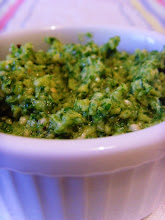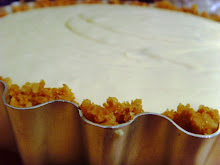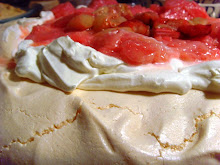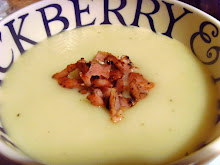 |
| Christmas Cake in disguise! |
It is with a mixture of apprehension and excitement that I await Christmas this year. It will be my first Christmas as a married woman and the first that I will be the one hosting the festivities. It will be the first Christmas I will spend with my in-laws. It will also be the first Christmas I have spent away from my parents and family.
My mother has always played the most integral part in my Christmas. She is the sort of woman who does Christmas properly. She is the sort of woman who has five sets of Christmas placemats. The sort of woman who, over the years, has amassed a collection of 'special' dishes which come out only once a year. There is a special platter for the turkey, bowls featuring a Holly design for holding the brandy butter, a festive plate for the Christmas pudding and glasses etched with reindeer to delight her grandchildren (...and children for that matter). This may all sound rather kitsch, but I can assure you it is not - my mother's Christmas manages to be both artistic and tasteful whilst also being great fun.

My mother has been 'doing' Christmas for around fifty years so it is hardly surprising that she has perfected the art. Her tree is always beautifully decorated (red, silver and green only), there will be a lovely wreath on the door, a festive swag running up the staircase and a stunning flower arrangement in the centre of the dining table. Each year is the same and this is what I love. The familiarity of annual traditions, our Christmas Day routine (stockings, church, Champagne and smoked salmon, present opening, lunch...) and the joy of being with the people who know you the best.
The idea of a Christmas without all of this is quite alarming . Even more alarming is the fact that I want 'my' Christmas to be equally glorious yet I have none of the experience (or Christmas accessories) that my mother has accumulated over the years. Despite this level of alarm, I am actually looking forward to Christmas is my own home. I'm looking forward to staying put, not having to travel and just enjoying spending time with my husband in our new home. I'm looking forward to decorating the house 'our' way (though the red and silver theme is fairly ingrained) albeit on a very limited budget. And fortunately, my mother is willing to spare one of the sets of placemats!

I'm not entirely in the dark. I have cooked the Christmas lunch before and with some success. I have also been in charge of the Christmas pudding for the past few years - this has been made and is safely stored away maturing ahead of the big day. For my foolproof recipe,
please see this link. I've also made a Christmas cake before - I followed Delia's recipe and enjoyed the results but (guess what) it didn't quite match up to my mother's cake. To be fair to Delia, I actually prefer a slightly lighter-coloured cake to the traditional very dark fruit cake. The recipe that my family swear by is actually taken from an old wedding cake book. My sister is a professional wedding cake maker and this is the cake she uses for her cakes. It really is the nicest fruit cake I know of - beautifully moist, sticky and reasonably boozy yet quite pale rather than treacley-black.
The cake is best made at least three weeks in advance and left to mature nicely until ready to ice. An important part of the maturation is the addition of a soaking mixture which is drizzled over the cake sporadically whilst it matures.
The recipe is for one quantity of cake mixture. Underneath the ingredients I have listed the number of quantities according to the size and shape of your cake tins. This is also useful if you are making several tiers of a wedding cake. I made a 9 inch square cake and used 6 quantities of mixture. Unless you have digital scales, you may find it easier to use pounds and ounces to measure the ingredients - I give both!
My favourite Christmas Cake
Ingredients for one quantity of cake mixture. See below for guide to cake sizes.
2oz/57g plain flour
2oz/57g brown sugar
2oz/57g butter
2.5oz/71g currants
2.5oz/71g sultanas
1oz/28g seedless raisins
1oz/28g glace cherries
1.5oz/42g mixed peel
3/4 oz/21g ground almonds
2 tsp brandy or rum
1 large egg
pinch nutmeg
pinch mixed spice
pinch salt
1/4 lemon zest and juice
For 8 inch round, use 4 quantities of mixture and cook for approx. 3.5-4 hours
For 8 inch square, use 5 quantities and cook for approx. 4 hours
For 9 inch round, use 5 quantities and cook for approx. 4-4.5 hours
For 9 inch square, use 6 quantities and cook for approx. 4.5 hours
Soaking Mixture:
Equal quantities of rum, sherry and glycerine (or spirits of choice!). Glycerine is available from the chemist or, in small bottles, in the baking section of larger supermarkets. Add 1 tablespoonful per 1lb of cake when cooked.
1. Pre-heat oven to 140C. Line cake tin with a double layer of buttered greaseproof paper.
2. Clean the dried fruit by tipping onto a clean tea-towel and sprinkling with flour. Roll up in towel and agitate to release any bits of stalk/grit.
3. Halve the cherries then mix all the fruit together with lemon zest. Sift flour, spices and salt and set to one side.
4. Beat butter and sugar until light and fluffy. Gradually add eggs, beating after each addition. Stir in ground almonds and then fold in the flour and spices.
5. Add brandy or rum, fruit and lemon juice. Give everything a great big stir to combine ingredients thoroughly.
6. Transfer to prepared tin and place in center of oven. Below the cake place a roasting tin containing one pint of water. This will create sufficient humidity to keep the top of the cake moist and ensure level results in baking. Remove water after half the baking time (mind had evaporated by this stage!).
7. If the cake is browning too quickly, protect the top with a layer of foil or baking paper. Every oven differs and the timings are only a guide. My mother and sister tell me the cake usually takes much longer than the specified times in their ovens. In my oven, the timings seemed about right. Test the cake with a skewer to see if it is done.
8. When cake is ready, remove from oven and leave in the tin for 24 hours. After this time prick the top with a skewer, cocktail stick or knitting needle and sprinkle with appropriate quantity of soaking mixture (see above). Wrap cake in waxed paper for at least 3 weeks, topping up with soaking mixture if required.
As for decorating the cake... You'll just have to wait and see!





































